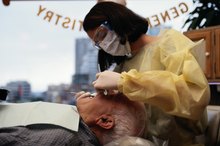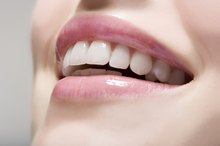Shark Teeth in Children
Children start to lose their baby teeth around age 4 or 5, and the process continues for several years. Usually it happens smoothly, with baby teeth falling out and their permanent replacements growing into the vacated spaces. Sometimes there are minor problems with the process. One of the most common is a condition called "shark teeth," which simply means that a permanent tooth comes in before the baby tooth is shed.
Definition
Shark teeth is a term used to describe the situation when a child's permanent teeth start to grow in before she loses her baby teeth. If a baby tooth is in the way, the permanent tooth simply sprouts up behind it. This gives the child two rows of teeth at once. The nickname comes from the fact that sharks also have a double row of teeth. Although shark teeth are most common with the lower incisors, they can also happen when the upper incisors or primary molars grow in.
- Shark teeth is a term used to describe the situation when a child's permanent teeth start to grow in before she loses her baby teeth.
- If a baby tooth is in the way, the permanent tooth simply sprouts up behind it.
Cause
What Causes the Mouth to Look Sunken As We Age?
Learn More
As youngsters grow, their permanent teeth usually dissolve the roots of their baby teeth. Once the root is nearly gone, a baby tooth gets loose. Eventually it will fall out, and many children accelerate the process by wiggling it and pulling on it. Then the permanent tooth can grow in the empty spot. With shark teeth, the root doesn't dissolve quickly enough. The baby tooth stays in place, and the permanent tooth works its way up in the space behind it.
- As youngsters grow, their permanent teeth usually dissolve the roots of their baby teeth.
- The baby tooth stays in place, and the permanent tooth works its way up in the space behind it.
Timeframe
The Cyber Dentist pediatric dentistry site says that shark teeth can happen at any time, but they are most common during two periods in a child's development 1. The first time is around age 6, when the lower front teeth usually grow in. The second is around age 11, when the upper back molars appear.
Assessment
How to Cover Missing Teeth in Your Mouth
Learn More
The Great Grins dental clinic says that shark teeth often don't need any treatment 2. If a permanent tooth hasn't come in all the way and the baby tooth is getting progressively looser, you don't have to worry about it because the situation will probably resolve on its own. If the new tooth continues to grow in and the baby tooth doesn't loosen, you should take your child to the dentist.
Treatment
Once a permanent tooth comes in completely behind the baby tooth, there is nothing to push or dissolve the root. This allows the baby tooth to stay in place. A dentist can treat this by extracting the baby tooth. The new tooth typically moves forward into the correct place once the obstruction is gone. It can take a few weeks, or even months, to completely move into position.
- Once a permanent tooth comes in completely behind the baby tooth, there is nothing to push or dissolve the root.
Related Articles
References
- Cyber Dentist article
- Great Grins article
- The American Dental Association. Eruption Charts. Oral Health Topics.
- The American Dental Association. Oral Health Topics. Eruption Charts.
Writer Bio
Based in Kissimmee, Fla., Barb Nefer is a freelance writer with over 20 years of experience. She is a mental health counselor, finance coach and travel agency owner. Her work has appeared in such magazines as "The Writer" and "Grit" and she authored the book, "So You Want to Be a Counselor."








